Making French toast without eggs might sound like a challenge, but it’s easier—and tastier—than you think. With the right ingredients and techniques, you can whip up vegan egg French toast that’s just as golden, crispy, and flavorful as the traditional version. In this guide, we’ll explore everything from choosing the perfect bread to creating delicious variations, so you can enjoy this plant-based breakfast staple any day of the week. Let’s dive in!
Introduction to Vegan French Toast
What Is Vegan French Toast?
Vegan French toast is a plant-based twist on the classic breakfast dish, made without eggs or dairy. Instead of traditional ingredients, it uses vegan egg substitutes like flaxseeds, chia seeds, or commercial egg replacers to mimic the creamy, binding properties of eggs. Paired with plant-based milk and a touch of sweetness, vegan French toast achieves that familiar soft, custardy interior with a perfectly crisp exterior.
This recipe isn’t just for vegans—it’s a hit with anyone looking for healthier, allergy-friendly, or sustainable meal options. Plus, it’s incredibly versatile, allowing you to customize flavors and toppings to your liking. Whether you’re a long-time vegan or just curious about plant-based cooking, this dish will surprise you with how delicious and satisfying it is.
Why Choose Vegan Egg Alternatives?
Why go vegan with your French toast? For starters, using plant-based egg alternatives is kinder to the planet, reducing your environmental footprint. Vegan substitutes are also cholesterol-free, making them a heart-healthy choice. Not to mention, they’re perfect for people with dietary restrictions or food allergies.
Vegan egg substitutes offer flexibility, too. From store-bought options like Just Egg to DIY blends like chickpea flour or banana mash, there’s a substitute for every taste and texture preference. By swapping out eggs, you’re not just making breakfast—you’re creating a meal that aligns with your values, health goals, and love for amazing flavors.
Why Vegan Egg French Toast Is Perfect for Everyone
One of the best things about vegan egg French toast is its universal appeal. Whether you’re vegan, lactose intolerant, allergic to eggs, or simply exploring plant-based meals, this dish fits the bill. It’s also a fantastic way to introduce friends and family to vegan cooking—without sacrificing flavor or texture. The recipe’s flexibility means you can adapt it to suit your preferences, making it as simple or as gourmet as you like. From a quick weekday breakfast to an elegant weekend brunch centerpiece, vegan French toast checks all the boxes.
Essential Ingredients for Vegan Egg French Toast
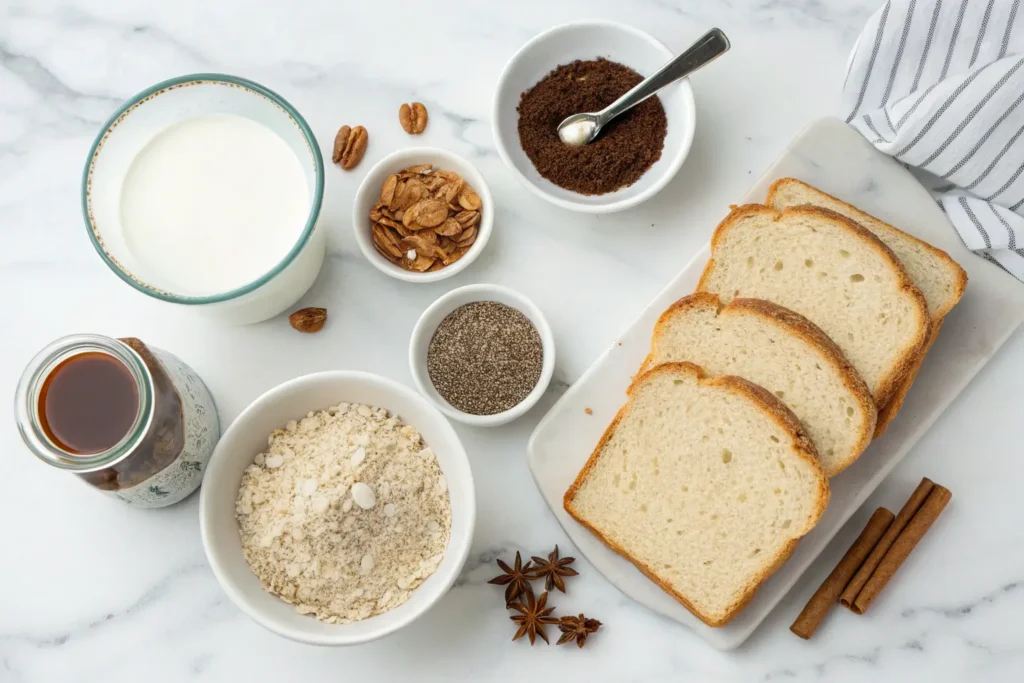
Selecting the Right Bread
When it comes to making vegan egg French toast, the bread you choose can make or break the dish. For the best results, go for slightly stale bread that can soak up the vegan egg mixture without falling apart. Thick-sliced options like sourdough, French bread, or brioche work wonders because they hold up well during cooking.
Avoid overly fresh or flimsy bread as it might turn soggy. If your bread is too fresh, consider toasting it lightly to firm it up. Whole-grain and gluten-free bread are also great alternatives for those with specific dietary needs.
Vegan Egg Substitutes
The star of any vegan French toast recipe is, of course, the egg replacement. Thankfully, there are plenty of options to suit every palate. Flaxseed and chia seeds are popular choices; they create a gel-like texture when mixed with water. For a smoother consistency, chickpea flour is a fantastic option—it’s protein-rich and has a neutral taste.
If you’re looking for convenience, try store-bought vegan egg replacers like Just Egg. These products are specifically designed to replicate the texture and binding properties of eggs, making your vegan egg French toast foolproof.
Plant-Based Milk Choices
The right milk can elevate your French toast from good to unforgettable. Almond, soy, oat, or coconut milk are excellent options, each bringing its unique flavor profile. Choose unsweetened varieties to control the sweetness of your dish, and experiment with flavored options like vanilla almond milk for added depth.
Flavor Enhancers
No French toast is complete without a little extra flavor. Add a splash of vanilla extract, a sprinkle of cinnamon, and a touch of sweetener like maple syrup to your batter. These simple additions take your vegan egg French toast to the next level, ensuring every bite is a delight.
Step-by-Step Guide to Making Vegan Egg French Toast
Preparing the Vegan Egg Mixture
Creating the perfect batter is the first step to a successful vegan egg French toast. Start by whisking your chosen vegan egg substitute—whether it’s a flaxseed mixture, chickpea flour, or Just Egg—with plant-based milk. The consistency should be similar to a traditional custard: smooth, creamy, and not too thick.
Next, stir in your flavor enhancers. Vanilla extract and cinnamon add warmth, while a pinch of salt balances the sweetness. For an extra touch, mix in a tablespoon of nutritional yeast to give your batter a subtle, savory depth that mimics traditional French toast.
Soaking the Bread
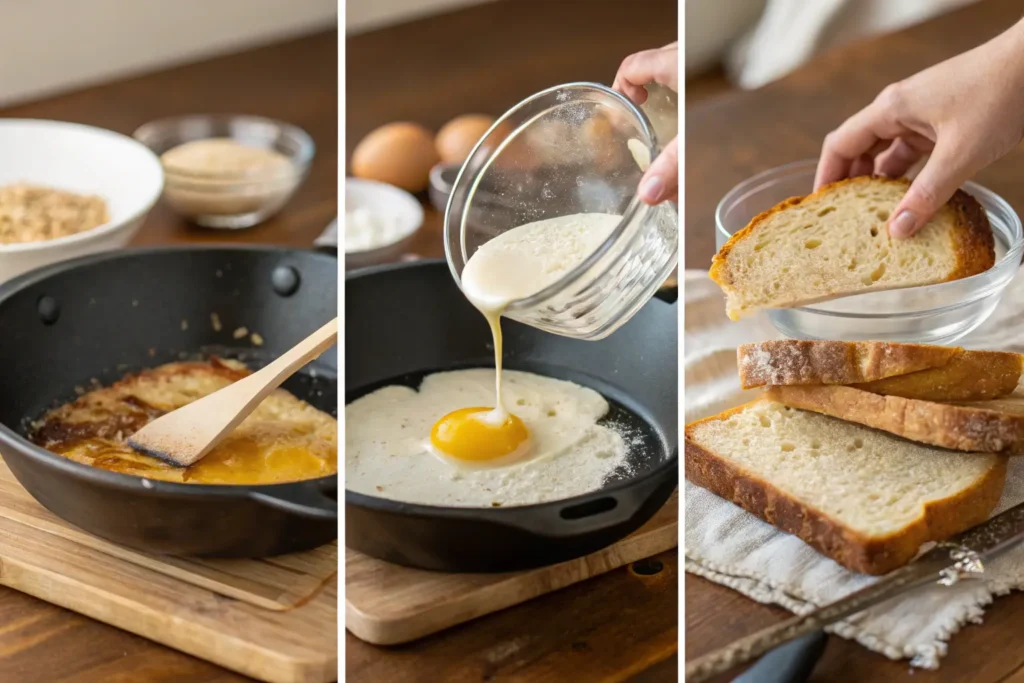
Once your batter is ready, it’s time to soak the bread. Place each slice into the mixture and let it sit for about 20–30 seconds on each side. Be careful not to over-soak, as the bread may become too soft and break apart.
Use a flat spatula to handle the bread, ensuring it’s evenly coated. If you’re working with thicker slices, allow a bit more time for soaking to ensure the batter penetrates the bread’s interior.
Cooking Techniques
Heat a non-stick skillet or griddle over medium heat and lightly grease it with vegan butter or oil. Place the soaked bread onto the hot surface, cooking each side for 3–4 minutes until golden brown and crispy. Keep an eye on the heat—too high, and your toast might burn before the inside is cooked.
For an even cook, press down gently with your spatula. This helps achieve that coveted crisp exterior while keeping the inside soft and custardy.
Common Mistakes to Avoid
Even the simplest recipes can go wrong without a little know-how. Avoid overcrowding the pan; cooking in batches ensures each slice has enough space to brown evenly. Also, don’t rush the soaking process—undercooked bread won’t absorb the batter properly, leaving your vegan egg French toast dry and bland.
Finally, taste your batter before soaking the bread. Adjust the sweetness or spice levels to suit your preferences, ensuring a perfectly balanced flavor in every bite.
Delicious Variations of Vegan French Toast
Stuffed Vegan French Toast
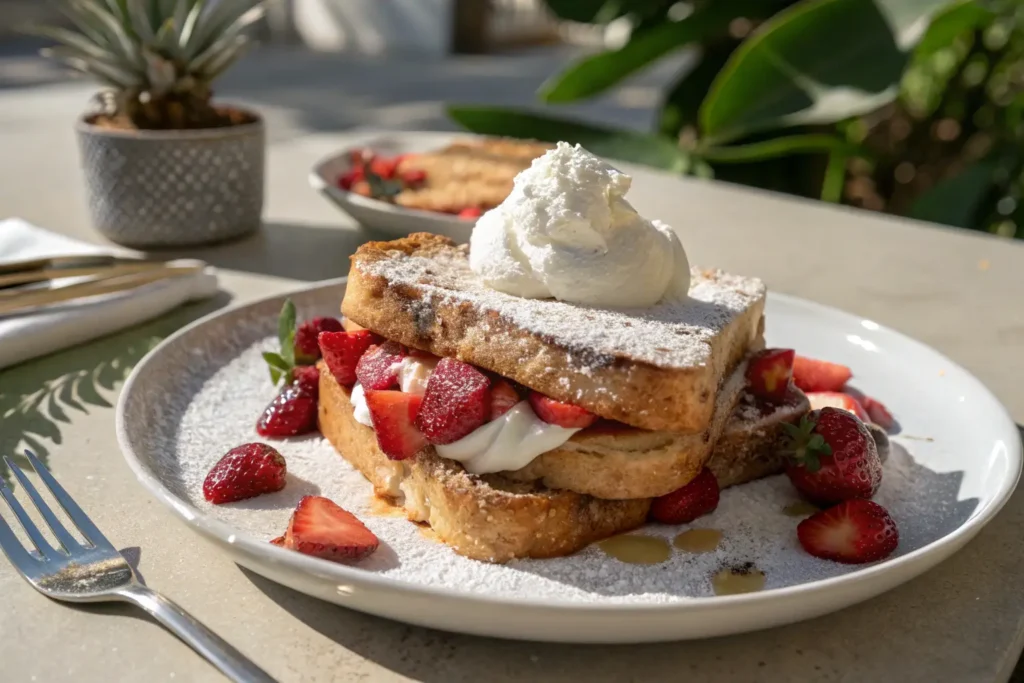

Elevate your vegan egg French toast by adding a delightful filling. Spread a layer of vegan cream cheese, almond butter, or mashed bananas between two slices of bread before dipping them into the batter. This creates a rich, indulgent center that contrasts beautifully with the crispy exterior. For a fruity twist, add sliced strawberries or blueberries to the filling, bringing a burst of freshness to each bite.
Gluten-Free Vegan French Toast
For those with gluten sensitivities, enjoying French toast is still on the table. Opt for gluten-free bread varieties that are sturdy enough to hold up during soaking and cooking. The process remains the same: prepare your vegan egg mixture, soak the gluten-free bread, and cook until golden brown. The result is a delicious, allergen-friendly breakfast that doesn’t compromise on taste or texture.
Savory Vegan French Toast Options
Who says French toast has to be sweet? Transform your vegan egg French toast into a savory delight by omitting sweeteners and adding spices like turmeric, nutritional yeast, and black salt (kala namak) to your batter. Top with sautéed mushrooms, avocado slices, or vegan cheese for a hearty meal that’s perfect for brunch or even dinner. This savory spin offers a unique way to enjoy a classic dish, catering to those who prefer savory over sweet.
Serving Suggestions and Toppings
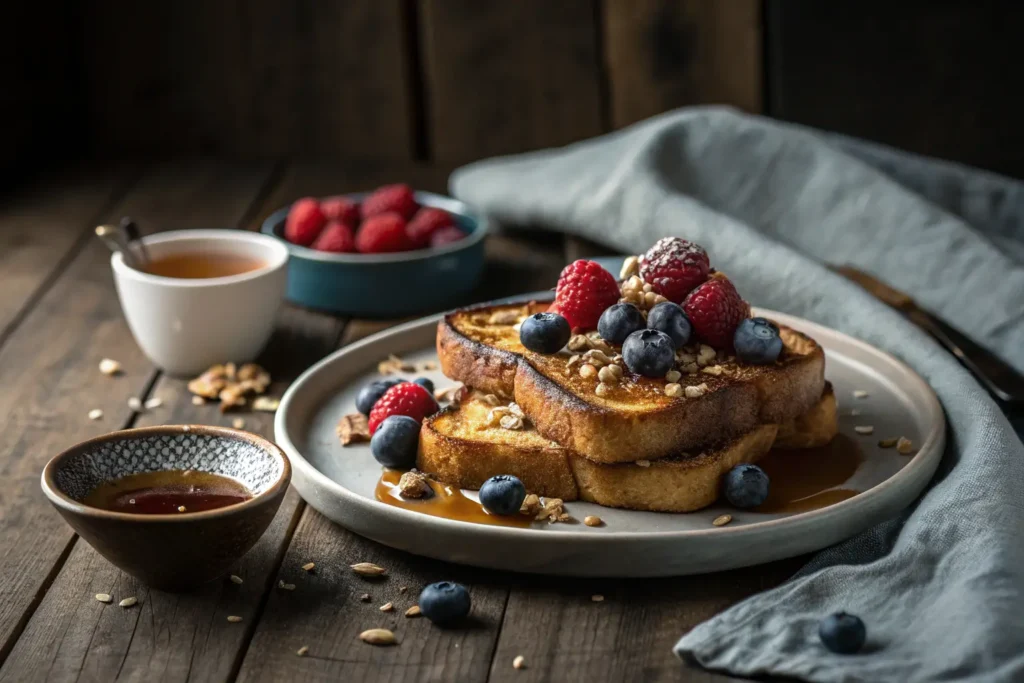
Fresh Fruit and Berries
For a creative breakfast option, check out 5 Easy Cream Cheese Bagel Ideas to Instantly Upgrade Your Breakfast.
Syrups and Sauces
Drizzling syrup over your French toast is a classic choice. Opt for pure maple syrup or agave nectar for a vegan-friendly option. For a gourmet touch, consider making a homemade berry compote or a coconut caramel sauce. These additions infuse your dish with rich flavors and can be customized to suit your taste preferences.
Nuts and Seeds
Sprinkle chopped nuts like almonds, walnuts, or pecans over your French toast to introduce a satisfying crunch and extra protein. Seeds such as chia or hemp can also be added for a nutritional boost. Toasting the nuts beforehand enhances their flavor, adding depth to each bite. This simple addition elevates your breakfast, making it both delicious and nourishing.
FAQs
1. Is eggy toast the same as French toast?
No, eggy toast and French toast are not exactly the same. Eggy toast typically refers to bread dipped in beaten eggs and fried, often savory. French toast, on the other hand, includes eggs and milk (or a milk alternative), often sweetened with sugar and flavored with vanilla or cinnamon. French toast is usually served with sweet toppings like syrup, fruits, or powdered sugar.
2. What is the trick to not soggy French toast?
The key to avoiding soggy French toast is:
- Use stale or slightly dry bread to absorb the egg mixture without becoming too soft.
- Don’t soak the bread for too long; a few seconds on each side is enough.
- Cook on medium heat to allow the inside to cook without burning the outside.
3. What do vegans use to replace eggs?
Vegans use various substitutes for eggs in recipes, such as:
- Flaxseed meal mixed with water (flax egg).
- Chia seeds mixed with water (chia egg).
- Mashed bananas or applesauce (especially in baking).
- Silken tofu or plant-based yogurt for creamy consistency.
4. How much flaxseed equals one egg?
To replace one egg, mix 1 tablespoon of ground flaxseed with 3 tablespoons of water. Let it sit for about 5 minutes until it thickens into a gel-like consistency. This works great as a binder in recipes like French toast or baking!
Conclusion and Encouragement to Try the Recipe
Making vegan egg French toast is a simple yet rewarding way to enjoy a comforting breakfast or brunch. With its crispy edges, soft interior, and endless topping possibilities, this plant-based version proves that you don’t need eggs or dairy to create a delicious dish. Whether you stick with the classic recipe or experiment with variations, you’ll find this recipe is versatile enough to suit any taste.
So why wait? Gather your ingredients, try out the recipe, and savor the satisfaction of making a meal that’s not only delicious but also kind to the planet. Share it with family and friends or enjoy it as a special treat for yourself. Bon appétit!
If you’re hosting an event, explore Why Breakfast Burrito Catering Is Perfect for Every Event for more delicious ideas.

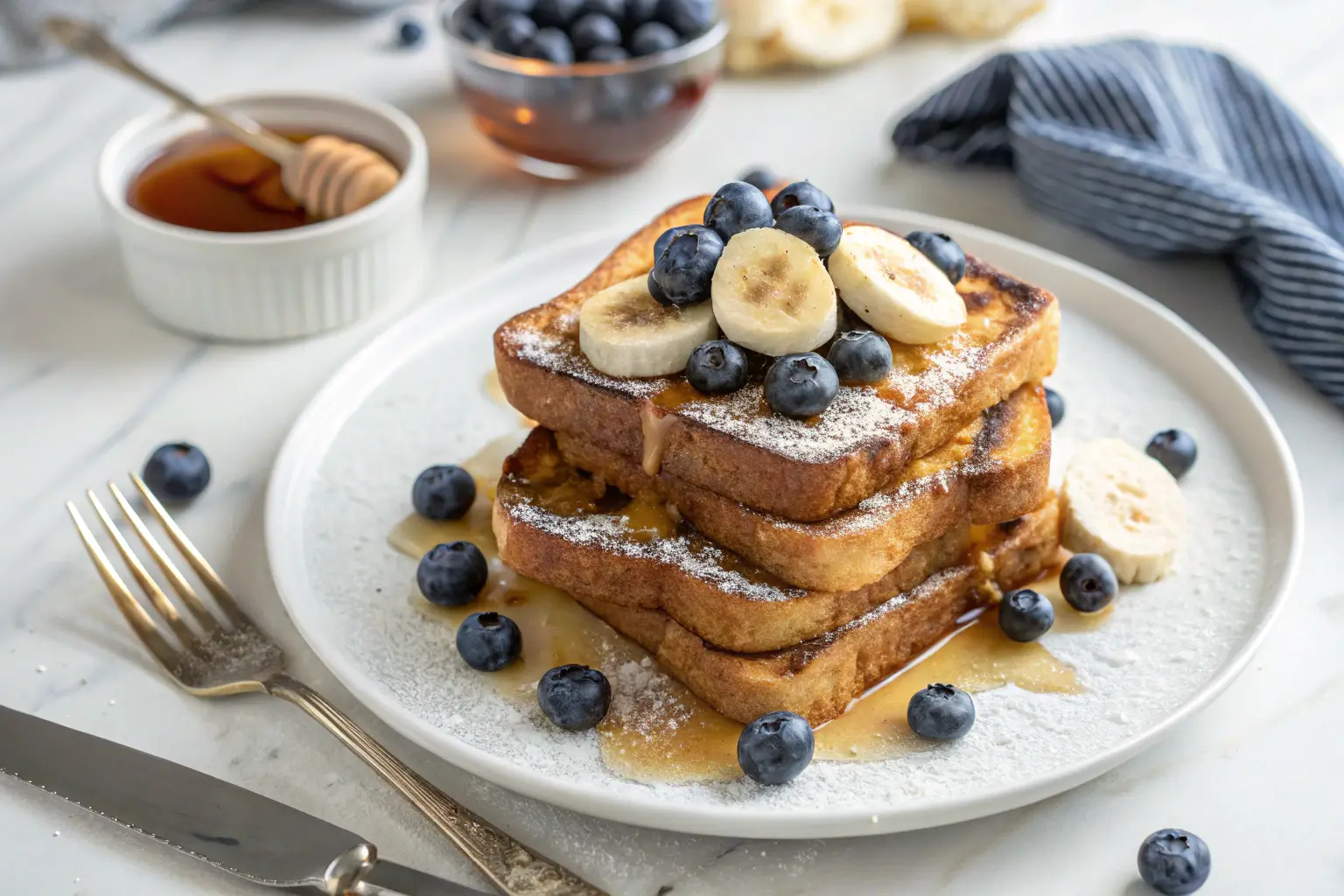
2 thoughts on “How to Make Perfect Vegan Egg French Toast in Just a Few Steps”